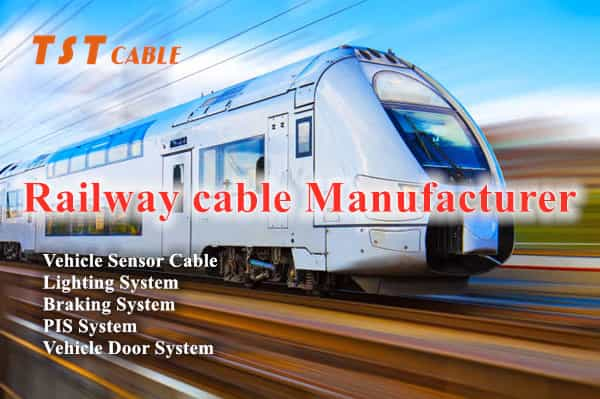
I. 26kV/35kV railway power cables types and features
Urban rail transit power supply system usually uses cross-linked polyethylene insulated power cables, especially 26kV/35kV grade cables. Cross-linked polyethylene insulated power cables (referred to as cross-linked cables) have excellent electrical properties and heat resistance, and are suitable for high-load, long-time operation of the power supply system.
Second, the characteristics of power cables commonly used in urban rail transit power supply system
- Power cable laying location
From the specific functional location, there are stations, tunnels, cable trench, cable mezzanine, cable wells, etc.; from the space, underground, elevated or ground. - Power cable laying method cable tray, cable tray, cable hooks, top hanging, etc. Sometimes used to wear steel pipe laying.
- Basic requirements
Underground:AC 26kV/35kV, according to different systems, through the calculation of different cross-sectional area selection, generally 1x95mm², 1x150mm², 1x240mm² (TST CABLES can be customized according to the actual demand)
Third, 26kV/35kV urban railway power cables structure
Cross-linked polyethylene insulated power cables of 26kV/35kV are usually composed of conductor, conductor shield, insulation, insulation shield, copper tape shield, non-woven fabric, outer sheath and other parts. Among them, the conductor is generally made of multi-stranded copper wire stranded to improve the flexibility and conductivity of the cable; conductor shielding and insulation shielding is used to optimize the electric field distribution, protection of the insulation layer; copper tape shielding to enhance the cable’s anti-jamming ability; non-woven fabric and outer sheath play a role in the protection and insulation.
Fourth, 26kV/35kV urban railway power cables performance requirements
Rated voltage: the rated voltage of the cable should meet the needs of urban rail transit power supply system, generally 26kV/35kV.
Temperature resistance: the cable should be able to operate normally under long-term operating temperature, usually the long-term operating temperature of the cable core is 90℃. At the same time, the cable should be able to withstand temperatures up to 250℃ under short-circuit conditions (short-circuit time not exceeding 5 seconds).
Flame retardant performance: Cables should have good flame retardant performance to meet the high safety requirements of urban rail transit. This is usually achieved by selecting low smoke non-halogen flame retardant materials.
V. 26kV/35kV urban railway power cables application scenarios
26kV / 35kV urban railway power cables are mainly used in the subway, light rail and other urban rail transit system power supply network, to provide a stable and safe power supply for the train. These cables are usually laid in tunnels, bridges, stations and other key locations to ensure the smooth operation of urban rail transit.
26kV/35kV urban railway power cables is an important part of urban rail transit power supply system, and its performance and quality are directly related to the stability and safety of the power supply system. Therefore, when selecting and using this kind of cable, its type, structure, performance requirements and application scenarios should be fully considered.
Six, cross-linked polyethylene insulated power cables
Cross-linked polyethylene insulated power cables (referred to as cross-linked cables) is a very promising plastic cable developed over the past 40 years. This cable has uniform electric field distribution, no tangential stress, light weight, high current-carrying capacity, and has been widely used in 6~35kV and 110kV, 220kV cable lines. 110kV or 220kV is to the urban rail transit power supply ring network system power supply, 35kV is the backbone of the urban rail transit power supply ring network system, in order to ensure that urban rail transit power supply system for the normal operation of the level of power grid is mostly used cross-linked polyethylene insulated power cable (referred to as cross-linked cable) is a very promising plastic cable developed in the past 40 years, which is a good choice. In order to ensure the normal operation of the urban rail transit power supply system, most of the power grids of this level use cross-linked polyethylene insulated power cables.
26kV/35kV cross-linked polyethylene insulated power cable selection recommendations
1.TST CABLES suggests cable selection principle
① The cable load capacity should meet the needs of long-term operation under various operating conditions with maximum load.
② The cable should be able to withstand the short-time short-circuit current of the system under various operating modes.
③ The selection of cable type should consider the convenience of project implementation.
④ Cable selection should meet the safety requirements of the subway and the requirements of different laying environments.
TST CABLES suggests the principle of cable cross-sectional area selection.
① When passing load current, the temperature of the wire core does not exceed the long-term working temperature allowed for cable insulation.
② The total cost of economic life is minimized (the total cost of economic life is the sum of the initial investment and the cost of line loss during the economic life).
③ The short-circuit current is passed without exceeding the permissible short-circuit strength.
④ Voltage loss is within the permissible range.
⑤ The machine is satisfied.
VII. Global Leading Railway Transportation Cable Manufacturer– TST CABLES
TST CABLES is a Chinese manufacturer focusing on the production of high-temperature wires and cables, the company’s production of 26kV/35kV railway power cables have been certified by CRCC, and all the performances have reached the requirements of the International Electrotechnical Commission, many national standards, and the industry. The railway cables are in compliance with a series of international and domestic standards, such as UL, EN, CUL, CSA, VDE, CCC. IATF 16949, ISO 9001, ISO 14001 ROHS, CRCC, REACH, EN50264, EN50382, EN50306, EN45545-2, TB/T1484.3, etc. TSTCABLES can process and customize according to the user’s demand for high temperature (1400℃), low temperature (-190℃), corrosion-resistant, corrosion-resistant, and high temperature resistant cables, corrosion resistance, anti-electromagnetic interference and other special cables. At present, we have loaded more than 500,000 cables on more than 3,500 high-speed rail coaches, running mileage of more than 6,000,000 kilometers. If you have any demands or questions about 26kV/35kV railway power cabless, please feel free to contact us by email to get free samples.
Also available in:
English

